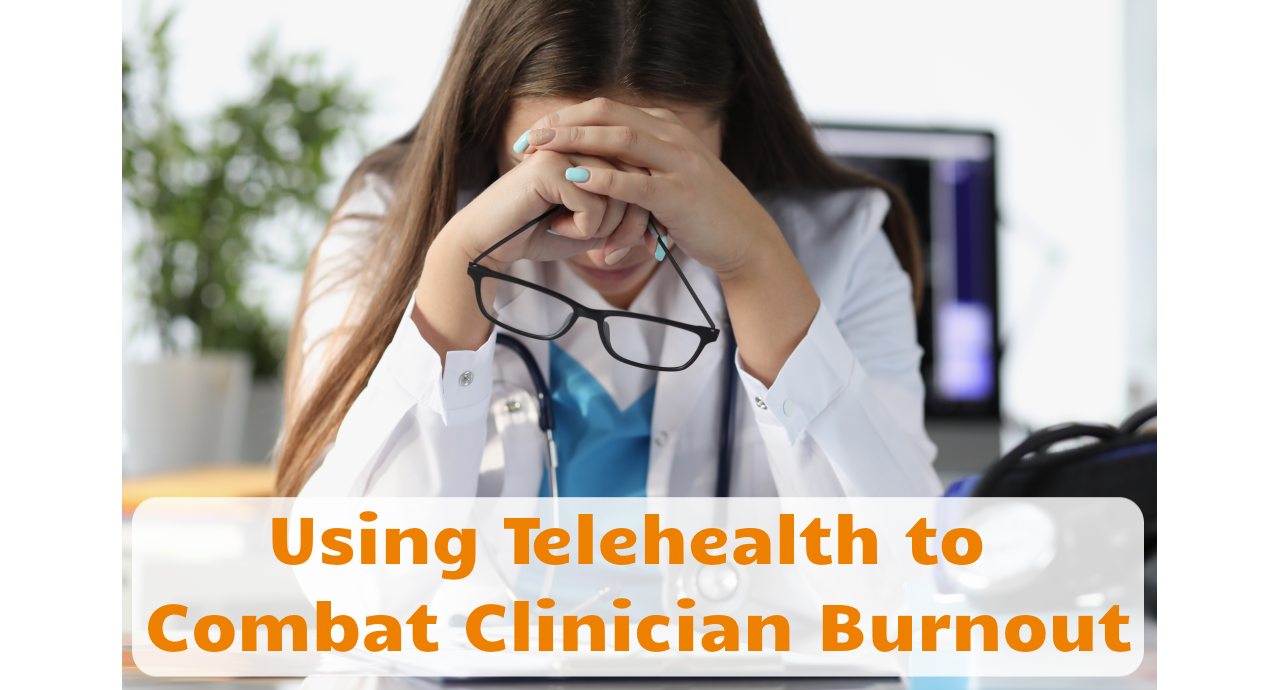Clinician burnout has long been a serious problem and the Covid-19 health crisis definitely did not help matters. But what if one of the side effects of the pandemic — the more positive views of telehealth by patients and by clinicians — could be used to actually combat burnout?
If you haven’t recently researched the topic, here are two eye-opening recent resources that describe the current state of burnout and the evolution over time:
- Medscape: Physician Burnout & Depression Report 2022
- Mayo Clinic Proceedings: Changes in Burnout and Satisfaction […] in Physicians Between 2011 and 2020
Two statistics stood out for me: That 58% of patients working in an outpatient setting are experiencing burnout and that 49% are trying to deal with their burnout without the help from a professional.
In this week’s article of Telehealth Tuesday, let me share with you a set of 6 tactics on how your organization can leverage telehealth to reduce burnout.
1. Design Effective Telehealth Workflows
I firmly believe that everyone in healthcare should, most of the time, only do the things that only they can do. Everyone — physicians, advanced practice providers, nurses, MAs, schedulers, front office staff, etc. — should use their unique skill set 80% of the time; and not spend their time doing things that others could be doing.
In an industry that mainly attracts “helpers” that will jump in to do what is needed for patient care, it can be hard to draw clear delineation as to what someone could be doing vs. what they should be doing.
As humans, we are most content when we are using our skills on a slightly challenging task. There’s a big rush of happiness hormones when we master a challenge using our skills. Conversely, there is boredom if the task is too easy, too repetitive, and not aligned with what we are uniquely qualified to do.
The solution lies in clearly defined workflows that lay out the “Happy Day Scenario” – what typically should happen most of the time. Each workflow must describe the activities that everyone on the team has to perform. This includes the 7 telehealth workflows of scheduling, onboarding, rooming, the visit, post-visit, follow-up, and billing.
2. Train Staff on the Workflows
To enable clinicians to focus on what they do best, the next tactic to combat clinician (and staff) burn out is to train all staff in the various workflows.
“Clarity is Kindness” and training on workflows will set clear expectations as to what level of performance is expected from each employee. Committed employees want to know how they can succeed, how they can “do it right”.
Well-designed workflows that in particular define the communication hand-offs that usually create most of the problems will address the majority of the existing challenges and lead to greater staff satisfaction.
3. Train Clinicians on technology and documentation
Learning and mastering a new skill is rewarding for most, but especially for clinicians. Part of clinicians’ psyche is to be masters of their domain and to bring that confidence into the exam room, being a trustworthy partner in the patient’s journey to wellness.
The actual “telehealth visit” should be pretty straight forward and akin to an in-person visit: Invite the patient from the virtual waiting room, conduct the visit while documenting in the EHR, then communicate the care plan and next steps. Done. Thus no training should be needed on how to conduct the actual visit.
But training is needed on the telehealth technology and also on how to properly document a telehealth visit – including virtual exams and proper billing codes.
Ideally the technology should be configured in a way that it is easy to use — and patients should be properly prepared (see the next tactic). But still, training on how to use the technology and on how to properly exhibit the right “webside manners” is key to a successful telehealth visit and to reduce stress and burnout.
4. Implement Telehealth TechChecks
Direct-to-Consumer telehealth, as I used to call it before the Covid-19 health crisis, has always been one of the trickiest telehealth flavors. That is mainly due to the fact that so many factors are outside of our control: the connectivity, the patient’s technical savvy, and the patient’s overall experience in using video chat technology, just to name a few of the challenges.
A Telehealth TechCheck is a proactive call to the patient a few days ahead of the visit, to make sure that the patient has adequate technology and connectivity and to orient the patient on the appropriate use regarding lighting, sound, and location.
The last thing we need in the battle against burnout is to turn our beloved clinicians into technical support professionals, walking clients through the appropriate settings. By the time the patient shows up in the waiting room, all of those things should have already been taken care of.



5. Schedule half-day blocks of Telehealth Visits
Now, with all the workflows, technology, and training out of the way to ensure that telehealth does not contribute to even more burnout, here is the first of two true game changers.
One of the contributors to clinician burnout in an outpatient practice is the “assembly line” nature of a steady stream of patients. What a block of telehealth visits can provide is a change of that pace, a way to break the relative monotony.
While the pace will be the same (or in most instances even faster, as telehealth visits tend to be shorter), the change in environment and level of interpersonal interaction can provide a respite from the in-person care delivery world.
Many clinicians I’ve worked with have described it as a “space to breathe” or a moment where they can “catch their breath”. They are typically not out in the hallway between visits and therefore not as vulnerable to interruptions.
6. Enable Clinicians to Telehealth from Home
An evolution of block scheduling telehealth visits is to actually have clinicians conduct telehealth visits from home. This could be for a day a week or for half a day (logistically ideally in the morning).
But conducting telehealth from home can also be used under other circumstances – e.g., during quarantine due to Covid exposure, during a mild illness, or other circumstances that, for example, only permit the clinician to work for a few hours a day.
By setting up a secure, private, high-performing home environment for clinicians, they can take an additional much needed break from the hectic everyday life of the clinic.
Let them do Telehealth!
Survey after survey has shown that today’s patients, or “Modern Healthcare Consumers” as I’d like to call them, truly enjoy the convenience of telehealth, especially if their clinician is confident and knowledgeable in using the technology. In a telehealth visit that is well set up, the technology quickly fades into the background and it becomes an intimate, trusting conversation from patient to doctor.
The patients’ gratitude for this option (which saves them the hassle of arranging transportation, baby sitters, taking time from work, etc.) further contributes to the clinicians wellbeing in serving their patients well.
Are you actively addressing clinician burnout? Have you established a baseline of burnout and are you leveraging telehealth as one tactic? I’d love to know if you do or want to!








To receive articles like these in your Inbox every week, you can subscribe to Christian’s Telehealth Tuesday Newsletter.
Christian Milaster and his team optimize Telehealth Services for health systems and physician practices. Christian is the Founder and President of Ingenium Digital Health Advisors where he and his expert consortium partner with healthcare leaders to enable the delivery of extraordinary care.
Contact Christian by phone or text at 657-464-3648, via email, or video chat.






